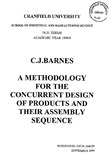JavaScript is disabled for your browser. Some features of this site may not work without it.
| dc.contributor.advisor | Jared, Graham | |
| dc.contributor.author | Barnes , C. J. | |
| dc.date.accessioned | 2009-03-30T15:09:45Z | |
| dc.date.available | 2009-03-30T15:09:45Z | |
| dc.date.issued | 1999 | |
| dc.identifier.uri | http://hdl.handle.net/1826/3319 | |
| dc.description.abstract | This thesis reports on the development of a Two-Tier methodology that provides support for assembly sequence construction, validation and evaluation in parallel with the design. This facilitates the production of products that are optimised for assemblability. The proposed approach diverges significantly from many of the sequence generation methods developed to date, which assume that assembly planning starts at the conclusion of the design process. It is believed that the latter approach misses an important opportunity to concurrently implement design and sequence improvements that would result in products inherently suited to assembly. The industrial assembly planning process was found to be completely different from the automatic sequence generation approach. The Two-Tier methodology has its foundations in this manual process, which uses a breadth-first, depth-second search. A constraint-based method is used to interactively validate the sequence. In direct contrast to traditional sequence generators, the hard and soft constraints are invoked throughout the process. A novel approach to sequence evaluation allows the user to quantitatively determine the suitability of the sequence at any time during the construction process. However, designers are rarely assembly experts and it is unreasonable to expect practical sequences to be generated without assistance. Thus, a set of generic assembly planning rules was identified from industrial surveys by the author. These were collaboratively implemented into an Expert Assembler, which currently consists of two mini advisors. Support is available to identify the most suitable base component and the most appropriate component to add next. The Two-Tier methodology has been implemented into a computer-based system called SPADE (Sequence Planning And Design Environment). A four-layer model holds the product data that underpins this implementation. The methodology and SPADE have been successfully tested using representative case studies and the results are reported as part of this thesis. | en_UK |
| dc.language.iso | en | en_UK |
| dc.publisher | Cranfield University | en_UK |
| dc.title | A methodology for the concurrent design of products and their assembly sequence | en_UK |
| dc.type | Thesis or dissertation | en_UK |
| dc.type.qualificationlevel | Doctoral | en_UK |
| dc.type.qualificationname | PhD | en_UK |
